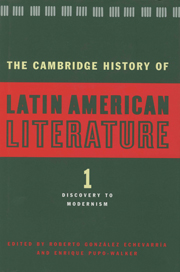Book contents
- Frontmatter
- Introduction to Volume 1
- 1 A brief history of the history of Spanish American Literature
- 2 Cultures in contact: Mesoamerica, the Andes, and the European written tradition
- 3 The first fifty years of Hispanic New World historiography: the Caribbean, Mexico, and Central America
- 4 Historians of the conquest and colonization of the New World: 1550–1620
- 5 Historians of the colonial period: 1620–1700
- 6 Colonial lyric
- 7 Epic poetry
- 8 Spanish American theatre of the colonial period
- 9 Viceregal culture
- 10 The eighteenth century: narrative forms, scholarship, and learning
- 11 Lyric poetry of the eighteenth and nineteenth centuries
- 12 Spanish American theatre of the eighteenth century
- 13 The nineteenth-century Spanish American novel
- 14 The brief narrative in Spanish America: 1835–1915
- 15 The Spanish American theatre of the nineteenth century
- 16 The essay in Spanish South America: 1800 to Modernismo
- 17 The essay of nineteenth-century Mexico, Central America, and the Caribbean
- 18 The gaucho genre
- Index
- Bibliographies
Introduction to Volume 1
Published online by Cambridge University Press: 28 March 2008
- Frontmatter
- Introduction to Volume 1
- 1 A brief history of the history of Spanish American Literature
- 2 Cultures in contact: Mesoamerica, the Andes, and the European written tradition
- 3 The first fifty years of Hispanic New World historiography: the Caribbean, Mexico, and Central America
- 4 Historians of the conquest and colonization of the New World: 1550–1620
- 5 Historians of the colonial period: 1620–1700
- 6 Colonial lyric
- 7 Epic poetry
- 8 Spanish American theatre of the colonial period
- 9 Viceregal culture
- 10 The eighteenth century: narrative forms, scholarship, and learning
- 11 Lyric poetry of the eighteenth and nineteenth centuries
- 12 Spanish American theatre of the eighteenth century
- 13 The nineteenth-century Spanish American novel
- 14 The brief narrative in Spanish America: 1835–1915
- 15 The Spanish American theatre of the nineteenth century
- 16 The essay in Spanish South America: 1800 to Modernismo
- 17 The essay of nineteenth-century Mexico, Central America, and the Caribbean
- 18 The gaucho genre
- Index
- Bibliographies
Summary
The conception of Spanish American literature as a distinct category emerged from romantic scholarship and was loosely based on deterministic and transcendental notions of history, tradition, and cultural milieu. Indeed, romantic literature represented with singular ease factual and legendary events that were often drawn from a broad legacy of texts. Yet, in the nationalistic context of nineteenth-century Spanish America, European belles lettres could not be assumed to be the sole precursor of an American literary tradition. Instead, influential authors of that period chose to look upon the early chronicles of discovery and exploration of the New World as fundamental components of Spanish American literary historiography and prose fiction. Such a foundational notion is suggested in the Infortunios de Alonso Ramírez (1680) and other writings by the Mexican savant Carlos de Sigüenza y Góngora (1645–1700). Much the same can be said of the Lazarillo de ciegos caminantes (1773), by the Spaniard Alonso Carrió de la Vandera (1715–1778). Predictably, the references to historiographic models represented by the narratives of Gonzalo Fernandez de Oviedo (1478–1557), Francisco López de Gómara (1512–1572) and Alvar Núñez Cabeza de Vaca (?1490–1557?), become more assertive in the essays and fictions written by the Argentinians Esteban Echeverría (1805–1851), Juan Bautista Alberdi (1810–1884), and by the Colombian José Caicedo Rojas (1816–1897), among others. Without intending to do so, the early chronicles of the Indies had consolidated, for readers of many nations, an American iconography and typology that was further codified in major poetic texts.
- Type
- Chapter
- Information
- Publisher: Cambridge University PressPrint publication year: 1996



